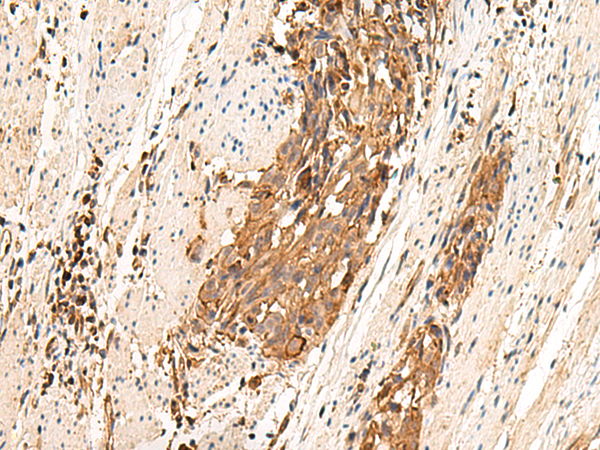
| WB | 咨询技术 | Human,Mouse,Rat |
| IF | 咨询技术 | Human,Mouse,Rat |
| IHC | 1/30-1/150 | Human,Mouse,Rat |
| ICC | 技术咨询 | Human,Mouse,Rat |
| FCM | 咨询技术 | Human,Mouse,Rat |
| Elisa | 1/5000-1/10000 | Human,Mouse,Rat |
| Aliases | MRGD; TGR7 |
| Host/Isotype | Rabbit IgG |
| Antibody Type | Primary antibody |
| Storage | Store at 4°C short term. Aliquot and store at -20°C long term. Avoid freeze/thaw cycles. |
| Species Reactivity | Human |
| Immunogen | Synthetic peptide of human MRGPRD |
| Formulation | Purified antibody in PBS with 0.05% sodium azide and 50% glycerol. |
+ +
以下是关于MRGPRD抗体的3篇参考文献及其简要摘要:
---
1. **文献名称**:*"Mas-related G protein-coupled receptor D (MRGPRD) marks a specific population of cutaneous sensory neurons"*
**作者**:Zylka, M.J. et al.
**摘要**:本研究利用特异性抗体通过免疫组化定位,发现MRGPRD选择性表达于小鼠背根神经节(DRG)中的无髓鞘C纤维神经元,揭示了其在皮肤感觉神经中的独特分布,提示其参与痛觉和温度感知。
2. **文献名称**:*"MRGPRD-expressing sensory neurons mediate protective reflexes in the skin"*
**作者**:Dong, X. et al.
**摘要**:通过抗体验证MRGPRD阳性神经元的功能,发现其参与机械性刺激的检测及保护性反射(如抓挠)。抗体阻断实验表明该受体在慢性瘙痒和炎症性疼痛中可能起调节作用。
3. **文献名称**:*"Targeting MRGPRD for chronic itch treatment: A monoclonal antibody approach"*
**作者**:Liu, Q. et al.
**摘要**:研究团队开发了一种抗MRGPRD的单克隆抗体,在动物模型中验证其可特异性抑制受体活性,显著缓解化学诱导的慢性瘙痒症状,为治疗瘙痒性疾病提供了潜在策略。
---
这些文献均涉及MRGPRD抗体的开发或应用,涵盖受体定位、功能研究及治疗潜力。如需具体年份或期刊信息,可进一步补充数据库检索。
MRGPRD (Mas-related G protein-coupled receptor D) is a member of the MRGPR family, a group of receptors predominantly expressed in sensory neurons. Discovered in the early 2000s, MRGPRD is implicated in mediating itch and pain signaling, particularly in non-peptidergic C-fiber neurons. Unlike other MRGPRs linked to histamine-independent itch, MRGPRD is activated by endogenous ligands like β-alanine and potentially other small molecules, though its full ligand profile remains under investigation. Its role in sensory processing has drawn attention as a potential therapeutic target for chronic pain, neuropathic disorders, and pruritus (chronic itch conditions).
MRGPRD antibodies are critical tools for studying receptor localization, expression patterns, and functional interactions. They enable immunohistochemical mapping of MRGPRD+ neurons in tissues, revealing its distribution in dorsal root ganglia and skin-innervating neurons. Additionally, these antibodies aid in characterizing receptor trafficking, ligand-binding dynamics, and downstream signaling pathways (e.g., Gαq/11 coupling). Recent studies also explore MRGPRD's involvement in mast cell activation and cross-talk with immune cells, broadening its relevance to inflammation and allergic responses. However, challenges persist in developing highly specific antibodies due to structural homology among MRGPR subtypes. Validated MRGPRD antibodies remain essential for deciphering its physiological roles and advancing drug discovery efforts aimed at modulating sensory and immune-related diseases.
×